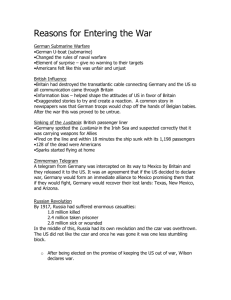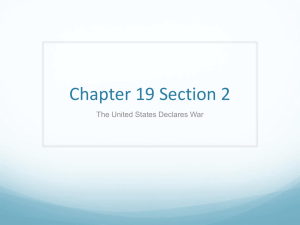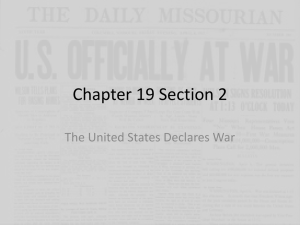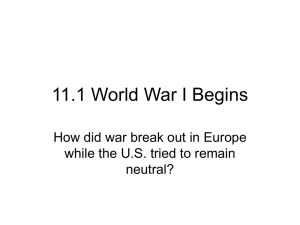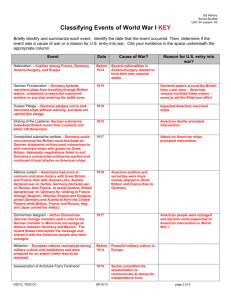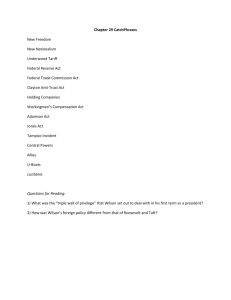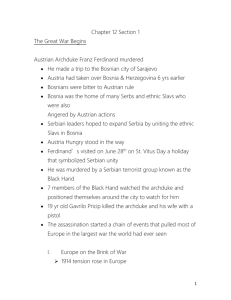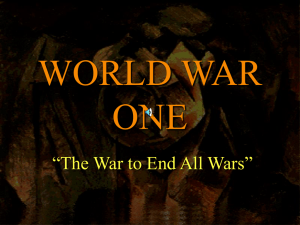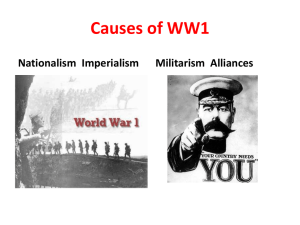WWI Textbook Outline - Mrs. Gilbert's Site
advertisement
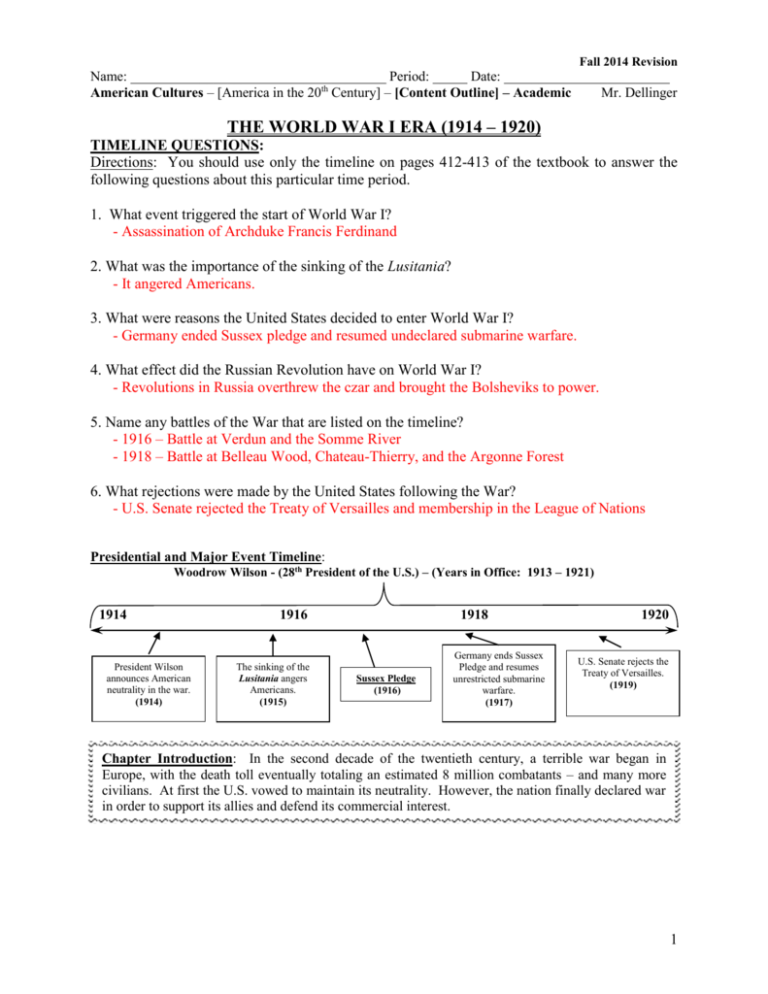
Fall 2014 Revision Name: _____________________________________ Period: _____ Date: ________________________ American Cultures – [America in the 20th Century] – [Content Outline] – Academic Mr. Dellinger THE WORLD WAR I ERA (1914 – 1920) TIMELINE QUESTIONS: Directions: You should use only the timeline on pages 412-413 of the textbook to answer the following questions about this particular time period. 1. What event triggered the start of World War I? - Assassination of Archduke Francis Ferdinand 2. What was the importance of the sinking of the Lusitania? - It angered Americans. 3. What were reasons the United States decided to enter World War I? - Germany ended Sussex pledge and resumed undeclared submarine warfare. 4. What effect did the Russian Revolution have on World War I? - Revolutions in Russia overthrew the czar and brought the Bolsheviks to power. 5. Name any battles of the War that are listed on the timeline? - 1916 – Battle at Verdun and the Somme River - 1918 – Battle at Belleau Wood, Chateau-Thierry, and the Argonne Forest 6. What rejections were made by the United States following the War? - U.S. Senate rejected the Treaty of Versailles and membership in the League of Nations Presidential and Major Event Timeline: Woodrow Wilson - (28th President of the U.S.) – (Years in Office: 1913 – 1921) 1914 President Wilson announces American neutrality in the war. (1914) 1916 The sinking of the Lusitania angers Americans. (1915) 1918 Sussex Pledge (1916) Germany ends Sussex Pledge and resumes unrestricted submarine warfare. (1917) 1920 U.S. Senate rejects the Treaty of Versailles. (1919) Chapter Introduction: In the second decade of the twentieth century, a terrible war began in Europe, with the death toll eventually totaling an estimated 8 million combatants – and many more civilians. At first the U.S. vowed to maintain its neutrality. However, the nation finally declared war in order to support its allies and defend its commercial interest. 1 American Cultures – Content Outline – Section 1 – “The Road to War” – [Please Note: Information can be found in textbook Chapter 12 – Section 1]: Main Idea: As World War I began and then spread to much of Europe, the U.S. tried to remain neutral as long as possible. 1. (A) What happened on June 28, 1914? Where? Who was responsible? - While visiting in Sarajevo - the capital of Bosnia, Archduke Francis Ferdinand, the heir of Austria-Hungary, and his wife (Sophie) were assassinated by Bosnian nationalist Gavrilo Princip. (B) Why did this act occur? - Gavrilo Princip shot him out of revenge because he believed that Austria-Hungary had no right to rule Bosnia (which had recently been taken over and become a new province of Austria-Hungary). CAUSES OF WORLD WAR I 1. Why was World War I called the “Great War”? It was the “war to end all wars.” 2. Explain how the following factors lead to the beginning of World War I? CAUSES OF WORLD WAR I IMPERIALISM MILITARISM NATIONALISM EXPLANATION A policy in which one nation takes control of the economic or political affairs of another country or region (Nations competed for power/land, which led to wars - ex: Spanish American War) Policy of aggressively building up strong armed forces to prepare for war and giving the military more authority over government and foreign policy (Competition between different countries and endless planning for war made war much more likely to occur) Tendency for countries to act in their own national interest, which could lead to warfare when such action went against the national interest of another nation. Also, countries with diverse ethnic populations seeking self-government/independence often led to violence. →Pride in one’s country and unity (mistrust and hatred towards other countries) ALLIANCES Triple Entente – Great Britain, France, Russia (Later, the U.S. joined after Russia exited the war) Triple Alliance – Germany, Austria-Hungary, Ottoman Empire (now known as Turkey) 2 THE CONFLICT EXPANDS 1. How did each of these nations end up in World War I? (A) Austria-Hungary – Convinced that Serbia was behind the assassination of Arch-Duke Ferdinand, Austria-Hungary declared war on Serbia on July 28, 1914, and crushed its small enemy. (B) Russia – As Serbia’s protector, Russia began mobilizing its troops for war the next day. (C) Germany – As Austria-Hungary’s chief ally, Germany demanded that Russia stop readying its troops. When Russia refused, Germany began mobilizing its troops to prepare for war against Russia. Then, on August 1, 1914, Germany declared war on Russia. France – When Russia refused to stop mobilizing, France began mobilizing its troops to support its ally, Russia, in its fight against Germany. (D) Great Britain – Germany’s invasion of Belgium (in order to quickly reach and defeat France) drew Great Britain into the war on August 4, 1914. (F) Construct a timeline using the events listed above: (A) (B) (C-Germany) (C-France) (D) June 28, 1914 July 29, 1914 August 1, 1914 August 3, 1914 August 4, 1914 2. (A) What was the name of the German War strategy? Schlieffen Plan (B) Give a brief overview of the strategy: To avoid fighting both the French and Russian armies at the same time, Germany called for a quick sweep through France (by passing through the neutral country of Belgium) to knock the French out of the war. Then, the German army would turn east and defeat Russia. 3. Use the Map on Page 415 to Answer the Following Questions: The Powers in World War I Central Powers: * Germany * Austria-Hungary * Ottoman Empire (a.k.a Turkey) * Bulgaria Allied Powers: * Russia (left war in 1917) * France * Great Britain * U.S. (entered war in 1917) * Italy * Romania, Greece * Africa * Serbia * Belgium, Portugal 3 4. Describe World War I using the following graphic organizer as a template: Where were the Eastern/Western Fronts Trench Warfare - A combined British and French force faced off against Germans in fortified lines of muddy, rat-infested trenches across an empty “no man’s land,” but neither side gained advantage - Eastern – Allies - Western – Central Powers World War I [War Conditions] - Very high – up to 20,000 deaths in a single day of combat - Bloody stalemate - Desperate to gain advantage, both sides began using any tactic – killing civilians and livestock, burning fields, planting bombs, torpedoing ships, blockading/starving people Death Toll - New efficient machines and modernized firepower/weaponry - machine guns - rapid-fire artillery - improved artillery shells - hand grenades - poison gases Military Advancements 4 THE AMERICAN RESPONSE 1. (A) What groups of Americans favored the Central Powers? - German-American and Irish American immigrants (B) Why did most Americans oppose the Central Powers? - Americans who traced their roots to Britain or who identified with British history, literature, and culture - Immigrants from Italy and some parts of Austria-Hungary 2. (A) Why were Americans so critical of the Germans? Who led Germany? - They mistrusted Kaiser Wilhelm II of Germany because his autocratic rule offended supporters of democracy. They also saw Germans as a people of frightening militarism and cold-blooded efficiency and/or believed the false propaganda stories told about the Germans. (B) Define Autocrat – A ruler with unlimited power 3. (A) Define Propaganda – False information intended to sway public opinion (B) How did propaganda play a big role in this war? - These stories turned American public opinion against Germany. 4. Why did the United States proclaim its neutrality on August 4, 1914? - To protect its commercial trade investments overseas American Cultures – Content Outline – Section 2 – “The United States Declares War” – [Please Note: Information can be found in textbook Chapter 12 – Section 2]: Main Idea: German submarine warfare helped push the U.S. into World War I. 1. Who would the United States side with in World War I? The Allies GERMAN SUBMARINE WARFARE 1. How did these actions anger the U.S.? (A) German U-Boat Warfare – - German U-Boat warfare changed the rules of naval warfare because U-Boats could remain virtually undetected, hidden under water, and could, therefore, fire on merchant and passenger ships without warning. Blockading Britain with submarine attacks was viewed by many Americans as uncivilized and enabled Germany to break a stalemate at sea against Britain. (B) The sinking of the Lusitania (1915) – - A German U-Boat, suspecting that the Lusitania (a British passenger ship) was transporting supplies for the Allies, fired upon and sank the Lusitania, which killed 1,200 passengers, including 128 Americans. Americans saw this as an act of “barbarism.” 5 2. How did President Wilson react to the sinking of the Lusitania? - He demanded that Germany stop its submarine warfare and make payments to the victims’ families. At first, Germany protested but then promised to stop sinking passenger ships without warning, as long as the ship’s crew did not resist German searches or seizures. 3. What was the Sussex Pledge? - When Germany continued to torpedo Allied ships, including the Sussex, a French passenger steamship, which killed 80 passengers (including 2 Americans), President Wilson threatened to cut diplomatic ties to Germany. At that point, the German government again promised that U-Boats would warn ships before attacking. This promise came to be known as the Sussex Pledge. MOVING TOWARD WAR 1. What were the results of the Election of 1916 – [Discussed in Chapter 11 – Section 3]? Democrats – Woodrow Wilson Popular Vote: 9,130,861 (49.25%) Electoral Vote: 277 (52.2%) Republicans – Charles Evans Hughes Popular Vote: 8,549,700 (46.11%) Electoral Vote: 254 (47.8%) 2. (A) Why did Germany break the Sussex Pledge? - Germany informed the U.S. that it would end the Sussex pledge and resume unrestricted submarine warfare knowing that doing so might bring the U.S. into the war. However, they thought they could defeat Britain and win the war in France before American entry in the war could make a difference. (B) How did the United States react to this? - The U.S. broke off diplomatic relations with Germany. A few weeks later, Wilson asked Congress for permission to arm American merchant ships. 3. (A) What was the Zimmermann Note? - A telegram in which Arthur Zimmerman, Germany’s foreign secretary, made a secret offer to Mexico. If Mexico declared war on the U.S., he wrote, Germany would reward it with American land in the Southwest – Texas, Arizona, and California. (B) How did the United States react to the Zimmermann Note? - The U.S. did not take the note seriously. However, the telegram’s release caused the U.S. to edge closer to war. 6 4. When and why did the United States decide to enter the War? What was the Senate vote on the War Resolution? What was the House vote on the War Resolution? - On April 2, 1917, President Wilson went before Congress to request a declaration of war against Germany. On April 4, 1917, the U.S. Senate voted in support of the request (it passed 82 to 6), followed by the House (with 373 to 50 votes) 2 days later. So, on April 6, 1917, the U.S. officially declared war against Germany for 2 main reasons: a. Germany violated its pledge to suspend unrestricted submarine warfare b. Germany attempts to entice Mexico into an alliance against the U.S. (Zimmerman note) - There were several other factors that influenced U.S.’s decision toward entering the war as well, including Germany’s sinking of the Lusitania, propaganda, cultural ties, Americans’ desire to protect its allies and overseas business interests, and Russia being forced to pull out of the war (as a result of the Russian Revolution that had occurred there). American Cultures – Content Outline – Section 3 – “Americans on the European Front” – [Please Note: Information can be found in textbook Chapter 12 – Section 3]: Main Idea: American troops helped the Allies defeat the Central Powers in World War I. 1. In what ways was the United States unprepared for the War? - The U.S. army was outranked in size by the armies of 16 other countries - The U.S. Marines were far away from Europe, patrolling several Central American countries and American possessions in the Pacific - The National Guard needed training PREPARING FOR WAR 1. What were the first steps the United States took once we entered the war? - Congress sent the Allies naval support, supplies, arms, and $3 billion in loans. Also, a force of 14,500 men led by General Pershing served mainly to boost Allied morale. However, Pershing soon realized that he would need more troops. 2. (A) How did the Selective Service Act work? - The Selective Service Act, which was passed in May 1917, required all young men (between the ages of 21-30) to register for military service. Believing this was going to be the “war to end all wars,” more than 24 million young men had registered for the draft. Of those, 3 million were drafted to serve in the war. (B) What was the American Expeditionary Force [AEF]? - A name given to American troops in Europe in WWI, made up of draftees, volunteers, and National Guardsman. 3. (A) Discuss the training of these new soldiers? - The drafted men were sent to training camps around the country. There, they were trained to use a bayonet and a rifle, to dig a trench, put on a gas mask, and throw a grenade. They were also informed of the strategies of trench warfare. However, the amount of training (which was supposed to be several months) was not always adequate and was, therefore, cut short. 7 (B) How were soldiers transported to Europe? - To ensure their safe arrival in Europe, soldiers had to be transported by convoys, which consisted of a group of unarmed ships surrounded by a ring of destroyers, torpedo boats, and other armed naval vessels equipped with hydrophones to track and destroy submarines. 4. (A) How did John J. Pershing plan to use American troops? [Doughboys] - Pershing wanted to save his men’s strength for offensive moves. American troops surprised the British and French soldiers on the front lines with their strength, good health, and energy and became nicknamed the “doughboys.” (B) How were African-American troops used in the War? - African Americans served in segregated units and most never saw combat. The marines refused to accept them, the navy used them for menial tasks, and the army used them mostly for manual labor. TURNING THE TIDE OF WAR 1. (A) Who were the Bolsheviks? What did they succeed in doing? - Bolsheviks were followers of Vladimir Lenin, a Russian communist revolutionary. They violently overthrew Russia’s republican government. Lenin had promised to make peace with Germany if he successfully won control of his native land (of Russia). Thus, Germany had helped to arrange his return to Russia. Lenin then signed a peace treaty with Germany and Russia backed out of the war. (B) How did this affect World War I? - By Russia pulling out of the war, the Germans were now freed from the two-front war they had been forced to fight. They were then able to successfully break through the trenches and advance deep into Allied territory. 2. How was the United States counterattacking the new German offensive? - The U.S. helped the French save Paris, blunted the edge of the German advance, and began to turn the tide of the war. At the battle of Marne, 28,000 American troops joined the French in a counter-attack that forced the Germans back across the river and into retreat. The Second Battle of the Marne ended any German hopes for victory. 3. How did the Allies plan to counterattack? - Using tanks (new weapons that could cross trenches and roll through barbed wire), the Allies began to break the German lines. On August 8, at the battle of Amiens, the Allied armies stopped the German advance in the north and recaptured Germany’s gains from earlier in the year. The Allies insisted on total surrender before peace talks. In September, American and French soldiers continued to hit German strongholds and began to expel Germans from France and to cut their supply lines. Soon after, Germany retreated from the Argonne Forest and the region of the Meuse river. 4. How were airplanes used in the War by both sides? - Aircraft were first used to scout enemy positions, but soon were used in dogfights (aerial battles between fighter aircraft at close range). Pilots also shot down hot-air balloons, fired upon individual soldiers on the ground, and dropped bombs on enemy positions and on the railroads that carried supplies to the front. 8 5. Who was Eddie Rickenbacker? - An American fighter pilot (ace) who downed 26 enemy fighters ENDING THE WAR 1. When and where was the armistice signed? In a French railroad car on 11/11/1918 2. Briefly describe the extent of the 1918 flu epidemic? - It killed more people worldwide than all of the wartime battles. The epidemic, which struck people of all ages equally hard and could kill within a few days, spread easily in crowded and unsanitary conditions. As a result, people had to wear masks in public. More American soldiers died from influenza than from battle. Over half a million Americans and about 30 million people worldwide died from this virus. 3. (A) What were the death totals of the War [Use the Chart on Page 438]. Allied Powers Central Powers Died 4,889,000 3,133,000 Wounded 12,809,000 8,419,000 (B) What other types of suffering took place? - Many died of disease (influenza). Thousands had lost limbs to bullets and artillery shells. Many developed “trench foot” and had to get their feet amputated. Many were permanently blinded or had lung damage as a result of poison gas attacks. Still, others died of starvation or from genocide. American Cultures – Content Outline – Section 4 – “Americans on the Home Front” – [Please Note: Information can be found in textbook Chapter 12 – Section 4]: Main Idea: Americans and their government took extraordinary steps at home to support the war effort. FINANCING THE WAR 1. What were Liberty Bonds? How many were sold? - Special War Bonds to support the Allied cause – more than $20 billion worth MANAGING THE ECONOMY 1. How did these help to get the United States home front prepared to fight? A. War Industries Board – - The WIB oversaw the nation’s war-related production by distributing raw materials, telling manufacturers what/how much to produce, and fixing prices (in other words, it controlled industry). B. National War Labor Board – - NWLB worked to settle labor disputes that might disrupt the war effort. In exchange, labor leaders promised to limit labor problems in war-production industries. 9 C. War Trade Board – - WTB licensed foreign trade and punished firms suspected of dealing with the enemy. D. War Labor Policies Board – - WLPB set standards for wages, hours, and working conditions in war industries. Labor unions also won limited rights to organize and bargain collectively (in other words, it controlled workers) E. The Food Administration – - The FA worked to increase farm output and reduce waste so there would be more food for the troops fighting in the war. 2. How did the following help the war effort? A. Price Controls – Government determined pricing on the sale of food. B. Rationing – Goods were distributed to consumers in a fixed amount. C. Daylight Savings Time – - Turning the clocks ahead one hour for the summer increased the number of daylight hours available for work. It also reduced the need for artificial light and lowered fuel consumption. ENFORCING LOYALTY 1. What was the Committee on Public Information? - A committee established to rally popular support for the war through productions of short films, pamphlets explaining war aims, and posters advertising recruitment and Liberty Bonds. 2. In what ways did Americans show their dislike of Germans [Hate the Huns]? - Americans began calling them Huns, in reference to a people who had brutally invaded Europe in the 4th and 5th centuries. High schools stopped teaching German; Books by German authors were removed from shelves; German musicians were banned; German measles became “Liberty measles;” and a hamburger became a Salisbury steak. German shepherds were even called “police dogs.” American Cultures – Content Outline – Section 5 – “Global Peacemaker” – [Please Note: Information can be found in textbook Chapter 12 – Section 5]: Main Idea: When the fighting ended in Europe, President Wilson pressed for a treaty that would bring peace to the postwar world. 1. (A) Define Fourteen Points – - A proposal set by President Wilson in 1918 for a postwar European peace. (B) What was President Wilson’s hope for the Fourteen Points? - He hoped that these points would form the basis of peace negotiations. 10 THE PARIS PEACE CONFERENCE 1. (A) Who represented the United States at this conference? President Woodrow Wilson (B) What did he want and what did he not want? - He wanted to establish a permanent agency where countries could work together to resolve disputes peacefully and guarantee international stability. - He did not want the U.S. to take spoils/rewards (money or land from the war’s losers). 2. Who else was in the “Big 4”? How were their aims different from those of Wilson? - British Prime Minister David Lloyd George, French Prime Minister Georges Clemenceau, and Italian Prime Minister Vittorio Orlando - They were interested in making the Central Powers pay for their part in the war with land, goods, livestock, and money. They also wanted to divide up Germany’s colonies. 3. (A) What was the League of Nations? - An organization in which the nations of the world would join together to ensure security and peace for all its members (B) What were some of the ways they could try to keep peace? - Members of the League would regard an attack on one country as an attack on all, but the force would have to depend on the will of members to back it up with their armies - Remove trade barriers among nations - Reduce military forces - Respect the rights of native peoples in Germany’s colonies in Africa, China, and the Pacific. - Right of ethnic groups to self-determination (make decisions about one’s own future) (C) What did Republicans fear about the League? - Republicans feared that it could drag the U.S. into unpopular foreign wars and commit the U.S. to the League of Nations, which would threaten American independence. THE PEACE TREATY 1. In what ways did President Wilson get what he wanted? - League of Nations to ensure international security and peace was accepted (but with restrictions) 2. What war reparations did Germany have to pay? - Germany had to pay $33 billion. 3. (A) Define Versailles Treaty – - A treaty signed at Versailles (the former home of French kings) by Germany and the other great powers in 1919, which ended WWI (B) Why were the Germans forced to sign the Treaty of Versailles? - The Germans gave in after they were threatened with a French invasion. 11 REACTIONS AT HOME 1. What happened to Wilson after attempting to rally support for the League of Nations? - He suffered a stroke that paralyzed one side of his body. He remained an invalid thereafter for the rest of his term. 2. What was the Senate vote on the Treaty of Versailles [November 1919]? - The Senate rejected the treaty by a vote of 39 (yes) and 55 (no) 3. How did the United States finally make peace with Germany? - On May 20, 1920, Congress voted to disregard the Treaty of Versailles and declare the war officially over, but Wilson vetoed the resolution. Finally, on July 2, 1921, another joint resolution to end the war passed (Warren Harding was in office by then) and Congress ratified separate peace treaties with Germany, Austria, and Hungary that October. 12
